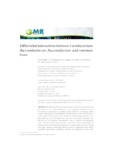Please use this identifier to cite or link to this item:
http://www.alice.cnptia.embrapa.br/alice/handle/doc/1057294| Title: | Differential interactions between Curtobacterium flaccumfaciens pv. flaccumfaciens and common bean. |
| Authors: | VALDO, S. C. D.  WENDLAND, A.   ARAÚJO, L. G.   MELO, L. C.   PEREIRA, H. S.   MELO, P. G.   FARIA, L. C.   |
| Affiliation: | STELLA CRISTINA DIAS VALDO, UNIVERSIDADE FEDERAL DE GOIÁS; ADRIANE WENDLAND FERREIRA, CNPAF; LEILA GARCES ARAUJO, UNIVERSIDADE FEDERAL DE GOIÁS; LEONARDO CUNHA MELO, CNPAF; HELTON SANTOS PEREIRA, CNPAF; PATRICIA G. MELO, UNIVERSIDADE FEDERAL DE GOIÁS; LUIS CLAUDIO DE FARIA, CNPAF. |
| Date Issued: | 2016 |
| Citation: | Genetics and Molecular Research, v. 15, n. 4, 2016. |
| Description: | Bacterial wilt of common bean caused by Curtobacterium flaccumfaciens pv. flaccumfaciens is an important disease in terms of economic importance. It reduces grain yield by colonizing xylem vessels, subsequently impeding the translocation of water and nutrients to the superior plant parts. The existence of physiological races in C. flaccumfaciens pv. flaccumfaciens has not so far been reported. The objective of the present investigation was to identify physiological races, evaluate differential interaction, and select resistant genotypes of common bean. Initially, 30 genotypes of common bean were inoculated with eight isolates exhibiting different levels of aggressiveness, under controlled greenhouse conditions. Disease was assessed 15 days after inoculation. The existence of differential interactions between C. flaccumfaciens pv. flaccumfaciens isolates and common bean genotypes were identified by utilizing partial diallel analysis. The most aggressive isolates were BRM 14939 and BRM 14942 and the least aggressive isolates were BRM 14941 and BRM 14946. The genotypes IPA 9, Ouro Branco, and Michelite were selected as more resistant among the test isolates. The genotypes IAC Carioca Akytã, BRS Notável, Pérola, IAC Carioca Aruã, and Coquinho contributed more to the isolate x genotype interaction according to the ecovalence method of estimation, and were, therefore, indicated as differentials. Based on these results, it was possible to conclude that physiological races of the pathogen exist, to select resistant genotypes, and to propose a set of differentials. |
| Thesagro: | Feijão Phaseolus vulgaris Melhoramento genético vegetal Resistência genética |
| NAL Thesaurus: | Plant breeding Aggression Genetic resistance Varietal resistance Pathotypes |
| Keywords: | Partial diallels Differentiating series |
| ISSN: | 1676-5680 |
| DOI: | 10.4238/gmr15048712 |
| Type of Material: | Artigo de periódico |
| Access: | openAccess |
| Appears in Collections: | Artigo em periódico indexado (CNPAF)  |
Files in This Item:
| File | Description | Size | Format | |
|---|---|---|---|---|
| CNPAF2016gmr1.pdf | 446.01 kB | Adobe PDF |  View/Open |









